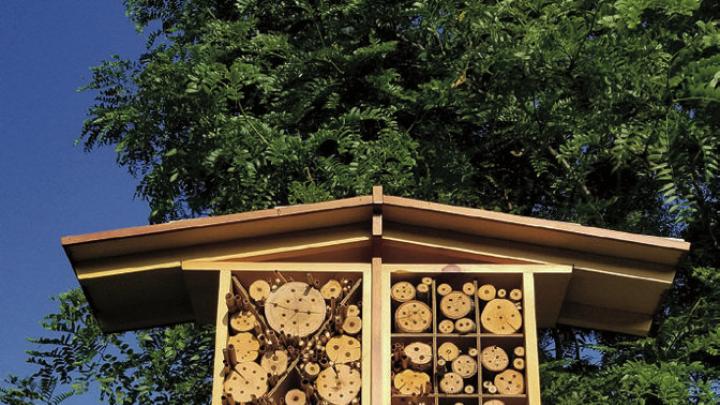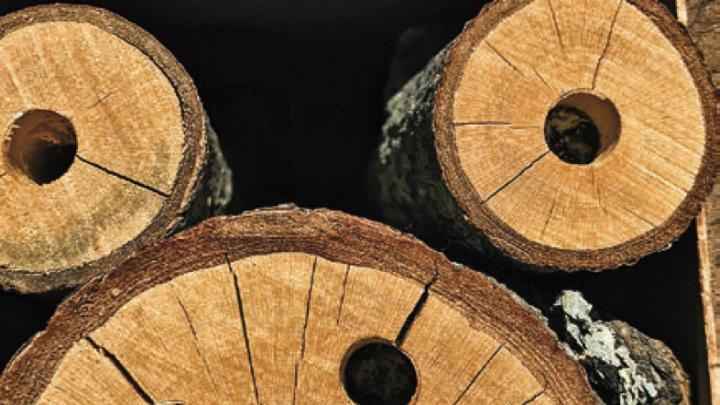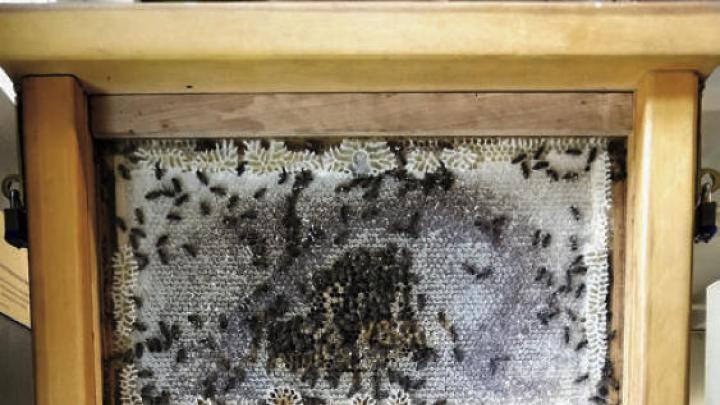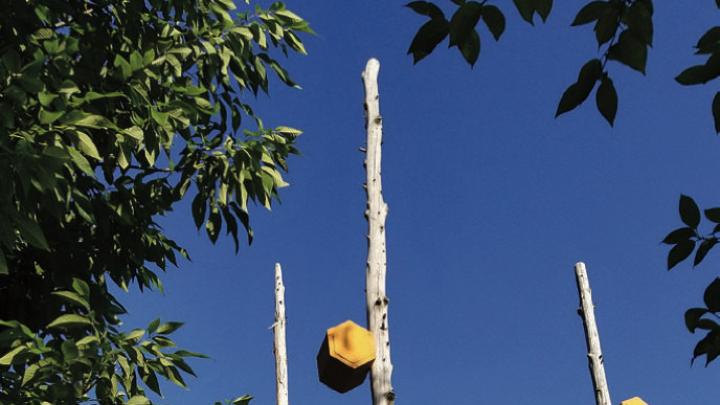The Harvard Museum of Natural History is home to all sorts of intriguing preserved specimens, from dinosaur skeletons to animals from around the world. But in one corner of the arthropod gallery, amid beetles and butterflies pinned to displays behind glass, the thousands of honeybees swarming in and out of a hive are very much alive.
The observation beehive, a project of the Harvard Undergraduate Beekeepers, opens on April 18 and is on display through the summer. It looks like a window set perpendicular to the wall, with a transparent plastic tube linking the hive to the outdoors. Visitors can try to identify female worker bees carrying out various duties, like foraging, constructing or guarding cells, or converting nectar, or look for the colony’s queen; she’s usually bigger than the male drones, and has been marked with a dot of paint by the beekeepers. Look for “tail-waggling” bees at the bottom of the hive, says Greg Morrow, a technical manager of multimedia projects at Harvard who advises the student group. The showy “figure-eight dance” is how a foraging bee communicates her discovery of new flowers, he explains: the longer she performs, the more bees she’ll recruit to go raid nearby treasure troves of pollen and nectar.
Even within Greater Boston’s dense urban environment, opportunities exist to watch bees work and learn not only about their essential contributions to food production, but about the practicalities of beekeeping as well. Honeybees are a focus at the museum, at the Harvard Square shop Follow the Honey, and at Mass Audubon’s Drumlin Farm Wildlife Sanctuary, in Lincoln, which produces and sells honey from its own hives and offers beekeeping classes and programs. Lesser-known but equally important native bee species are at the center of innovative endeavors at Harvard’s Arnold Arboretum and at nonprofit Groundwork Somerville’s urban South Street Farm.
The European honeybee, Apis mellifera, is a domesticated species imported to North America, which counts, in addition, some 4,000 native bee species. Roughly 400 of those species inhabit New England; yet with habitat loss and widespread pesticide use, these populations are increasingly threatened. The Beecology Project, spearheaded by a team that includes Worcester Polytechnic Institute associate professor Elizabeth F. Ryder, M.S. ’85, Ph.D. ’93, is helping to address that problem, in part by gathering data from citizen-scientists who use a mobile app to track native pollinators.
At the Arnold Arboretum, gardener Brendan P. Keegan last year helped build and now oversees six native-bee habitats across the 281-acre botanical oasis in Boston’s Jamaica Plain neighborhood—to boost the local bee population and “educate people about the diversity of pollinators that we have.”
The largest habitat, in the Leventritt Garden, is a wooden box stuffed with hollow reeds and logs with holes drilled into them to form pencil-sized cavities where individual bees make nests. It attracts mason bees and leafcutter bees. “Each female lays an egg at the far end, adds a small ball of pollen and nectar as a meal for the future larva, and then uses a plug of mud or specially cut leaves to wall off the egg, creating a cell,” Keegan explains: there are multiple cells per cavity, each holding one egg. “No-mow” zones are also left fallow among the arboretum’s beautiful specimen trees and ornate gardens, he says, in part to foster habitat-building for invertebrates. Most native bees, including sweat bees (named for their attraction to human perspiration), nest in the ground.
The Arboretum benefits, Keegan points out, because many native bees are more efficient pollinators than A. mellifera. “Honeybees have pollen sacks on the backs of their legs” and must wet the pollen to attach it, “whereas most of our native bees carry [more dry, loose] pollen on their abdomens,” he says. “When they’re going into a flower, they’re actually more efficient because they’re basically covered with pollen” and can distribute it more easily.
Many farmers are taking advantage of that efficiency, including the operators of South Street Farm, which relies on mason and leafcutter bees to pollinate crops. The quarter-acre Somerville site is an experiment in urban agriculture, and supplies produce to the community. Because local bee habitats were sparse, the organization built them: wooden poles in a corner of the farm hold boxes filled with hollow reeds where native pollinators nest. Anyone interested in learning more can stop by, or even join the farm’s volunteer ranks.
For those eager to support apiculturists, Follow the Honey sells small-batch honeys and beeswax products made in Massachusetts and around the world. Flavors and types of honey depend on the source of the nectar—whether wildflowers in Tanzania, ulmo trees in Patagonia, or tupelo trees in the Atchafalaya River basin of Louisiana. The store helps connect “unseen beekeepers to markets,” says chief of operations Brian Woerner, but its mission is also to share information: on how honey is made, on the challenges bees and beekeepers face, and on the environmental importance of these insects.
At the Harvard museum, bees in the observation hive do produce honey—but just enough for themselves. The exhibit invites close examination of these unique creatures that work so hard in a vital aspect of human food production. Morrow admires the intricacies of bee biology: “The more you observe,” he says, “the more incredible it becomes.”












